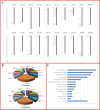Genome-wide mining seed-specific candidate genes from peanut for promoter cloning
- PMID: 30921362
- PMCID: PMC6438489
- DOI: 10.1371/journal.pone.0214025
Genome-wide mining seed-specific candidate genes from peanut for promoter cloning
Abstract
Peanut seeds are ideal bioreactors for the production of foreign recombinant proteins and/or nutrient metabolites. Seed-Specific Promoters (SSPs) are important molecular tools for bioreactor research. However, few SSPs have been characterized in peanut seeds. The mining of Seed-Specific Candidate Genes (SSCGs) is a prerequisite for promoter cloning. Here, we described an approach for the genome-wide mining of SSCGs via comparative gene expression between seed and nonseed tissues. Three hundred thirty-seven SSCGs were ultimately identified, and the top 108 SSCGs were characterized. Gene Ontology (GO) analysis revealed that some SSCGs were involved in seed development, allergens, seed storage and fatty acid metabolism. RY REPEAT and GCN4 motifs, which are commonly found in SSPs, were dispersed throughout most of the promoters of SSCGs. Expression pattern analysis revealed that all 108 SSCGs were expressed specifically or preferentially in the seed. These results indicated that the promoters of the 108 SSCGs may perform functions in a seed-specific and/or seed-preferential manner. Moreover, a novel SSP was cloned and characterized from a paralogous gene of SSCG29 from cultivated peanut. Together with the previously characterized SSP of the SSCG5 paralogous gene in cultivated peanut, these results implied that the method for SSCG identification in this study was feasible and accurate. The SSCGs identified in this work could be widely applied to SSP cloning by other researchers. Additionally, this study identified a low-cost, high-throughput approach for exploring tissue-specific genes in other crop species.
Conflict of interest statement
The authors have declared that no competing interests exist.
Figures




Similar articles
-
Isolation and characterization of a novel seed-specific promoter from peanut (Arachis hypogaea L.).Mol Biol Rep. 2019 Jun;46(3):3183-3191. doi: 10.1007/s11033-019-04775-x. Epub 2019 Apr 1. Mol Biol Rep. 2019. PMID: 30937655
-
Molecular Cloning and Functional Identification of a Pericarp- and Testa-Abundant Gene's (AhN8DT-2) Promoter from Arachis hypogaea.Int J Mol Sci. 2024 Jul 12;25(14):7671. doi: 10.3390/ijms25147671. Int J Mol Sci. 2024. PMID: 39062915 Free PMC article.
-
AhFAD3-A01 enhances α-linolenic acid content in Arabidopsis and peanut.Gene. 2025 May 15;949:149336. doi: 10.1016/j.gene.2025.149336. Epub 2025 Feb 20. Gene. 2025. PMID: 39986661
-
Cloning and functional characterization of seed-specific LEC1A promoter from peanut (Arachis hypogaea L.).PLoS One. 2021 Mar 22;16(3):e0242949. doi: 10.1371/journal.pone.0242949. eCollection 2021. PLoS One. 2021. PMID: 33750972 Free PMC article.
-
Enhancing medicinal proteins production in plant bioreactors: A focal review on promoters.Fitoterapia. 2025 Jan;180:106338. doi: 10.1016/j.fitote.2024.106338. Epub 2024 Dec 10. Fitoterapia. 2025. PMID: 39667679 Review.
Cited by
-
Molecular cloning and functional characterization of the promoter of a novel Aspergillus flavus inducible gene (AhOMT1) from peanut.Front Plant Sci. 2023 Feb 9;14:1102181. doi: 10.3389/fpls.2023.1102181. eCollection 2023. Front Plant Sci. 2023. PMID: 36844094 Free PMC article.
-
Comprehensive genomic characterization of NAC transcription factor family and their response to salt and drought stress in peanut.BMC Plant Biol. 2020 Oct 2;20(1):454. doi: 10.1186/s12870-020-02678-9. BMC Plant Biol. 2020. PMID: 33008287 Free PMC article.
-
Epigenetic regulation of seed-specific gene expression by DNA methylation valleys in castor bean.BMC Biol. 2022 Mar 1;20(1):57. doi: 10.1186/s12915-022-01259-6. BMC Biol. 2022. PMID: 35227267 Free PMC article.
-
Characterization of sucrose binding protein as a seed-specific promoter in transgenic tobacco Nicotiana tabacum L.PLoS One. 2022 Jun 3;17(6):e0268036. doi: 10.1371/journal.pone.0268036. eCollection 2022. PLoS One. 2022. PMID: 35657906 Free PMC article.
-
Genome-Wide Mapping of Quantitative Trait Loci for Yield-Attributing Traits of Peanut.Genes (Basel). 2024 Jan 23;15(2):140. doi: 10.3390/genes15020140. Genes (Basel). 2024. PMID: 38397130 Free PMC article.
References
Publication types
MeSH terms
Substances
LinkOut - more resources
Full Text Sources

